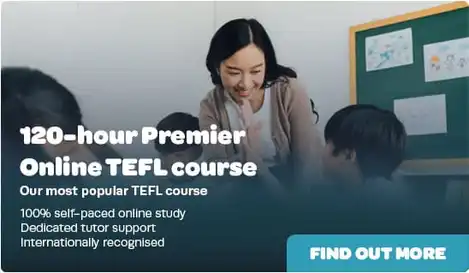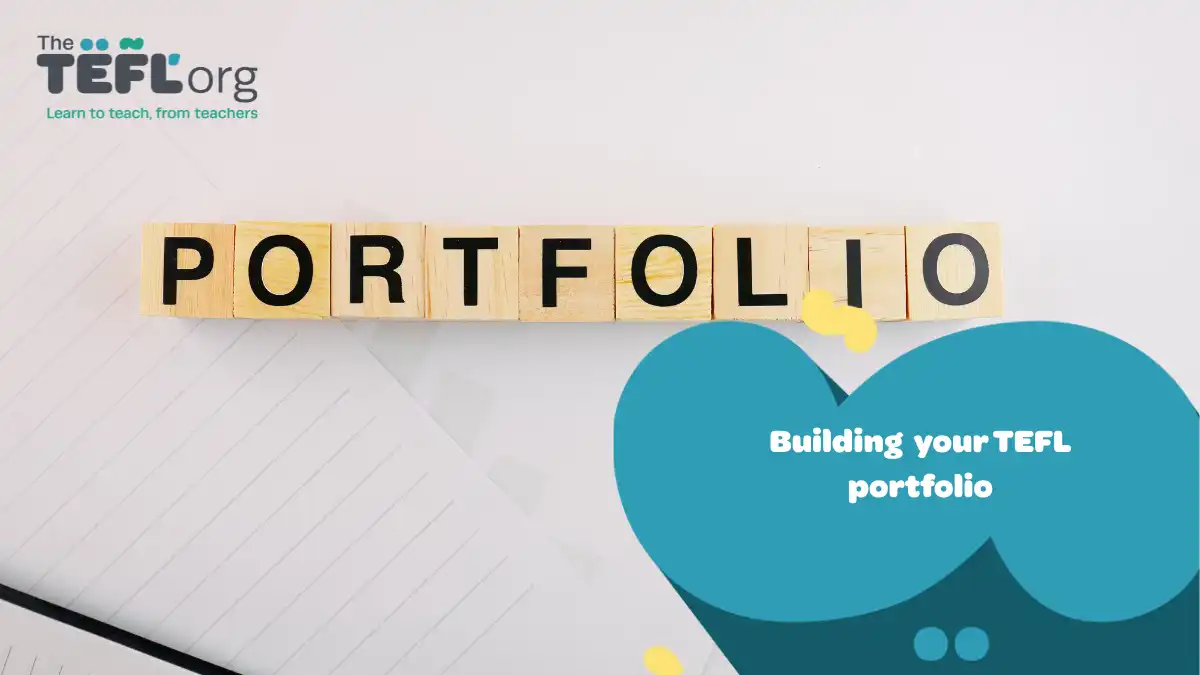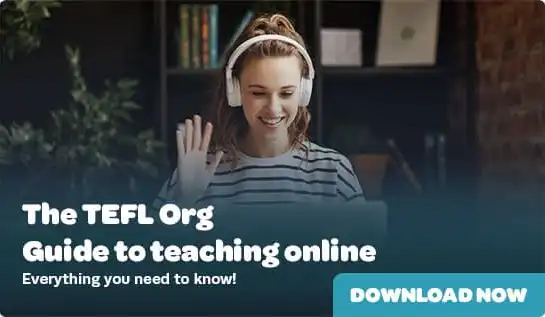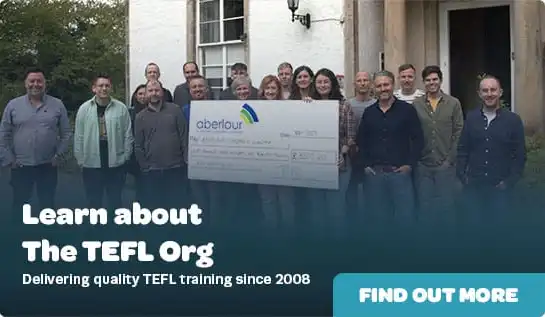- TEFL Courses TEFL Courses
- View all TEFL courses
- 120-hour Premier Online TEFL Course
- 250-hour Level-5 Online TEFL Course
- Online TEFL Courses
- Classroom TEFL Courses
- Combined TEFL Courses
- Virtual TEFL Courses
- TEFL Course Bundles NEW
- Advanced TEFL Courses
- TEFL Lesson Plans & Resources
- TEFL Gift Vouchers
- Which TEFL course is right for you?

- New to TEFL New to TEFL
- Locations
- TEFL Jobs
- Teach Abroad Teach Abroad
- Teach English Abroad
- Teach English in Japan
- Teach English in South Korea
- Teach English in Spain
- Teach English in China
- TEFL Salaries Abroad
- Requirements for teaching abroad
- Teach English abroad without a degree
- How to find teaching jobs abroad without experience
- Can you teach English abroad as a non-native speaker?

- Teach Online
- About Us
- Blog
- Podcast

Building your TEFL portfolio
The TEFL industry is competitive. Many talented English teachers with excellent qualifications, experience, and the right attitude are available to teach worldwide or online.
So, standing out when you’re applying for jobs is crucial. This goes beyond writing a fantastic CV/resume and cover letter (though they’re essential!). Creating a TEFL portfolio can give your application a real edge.
As we’ll cover, a TEFL portfolio is an opportunity to show off your skills. It’s a way to provide evidence of your experience, positive press coverage, student testimonials, and other valuable materials. When applying for jobs in the TEFL world, having a portfolio can really help you stand out.This blog post will help you define what makes a good TEFL portfolio. We’ll cover what should be there, how to create it, and why you should make one. Think of this as a companion to our CV/resume and cover letter guides!

What is a TEFL portfolio?
So, what is a TEFL portfolio, and why is it useful?
Think of your TEFL portfolio as a narrative of your teaching journey. It’s a collection of essential documents, testimonials from students/colleagues, and examples of your work. Picture it like a professional scrapbook demonstrating your growth and skills as a teacher.
Think of a TEFL portfolio as:
- An addition to your CV/resume and cover letter, offering examples of your work and ideas.
- The chance to show off your best work: your teaching philosophy, exam results, lesson plans, any awards or recognition you’ve achieved
Hiring managers at big institutions and employers at schools will enjoy seeing what you’re all about. In addition, they’ll get a sense of your personality, the why of your teaching career, and the what.

What should I include in my TEFL portfolio?
Now we’ve established the basic outline of why a TEFL portfolio is useful, let’s get into what should be included.
CV/Resume
No matter how shiny and beautiful your portfolio is, your CV/resume will always be the cornerstone of any job application. So, keep a current version of your CV/resume in your portfolio, and make sure it emphasises your qualifications, experience, and key skills, which can be summarised at the start of your CV/resume.
If you’re a new teacher and don’t have much experience, don’t panic. A portfolio is a great way to demonstrate the kind of TEFL teacher you want to be. For now, it’s all about making sure you have your qualifications front and centre.
Tip: If you're worried about lacking experience, read our guide on boosting your CV/resume for extra help.
Teaching philosophy
What’s your teaching philosophy ?
What is your teaching philosophy? Are you not sure? Don’t worry. Many teachers start by just doing what works. Later, they’ll realise that their approach mirrors a popular teaching philosophy.
Self-awareness is essential as a teacher, especially when putting together your portfolio. If an employer feels you are the right teacher for their institution, it’ll be a good fit for both parties.
So, are you a humanistic teacher who likes to foster an environment of creativity and self-directed learning? Are you more of a pragmatic teacher who wants students to learn things they can use in real life immediately?
Think about who you are as a teacher, and write about your approach.
Media coverage
This won’t apply to every teacher. However, if you’ve participated in fundraisers, contributed to a pupil’s success, or received positive media coverage, your portfolio is the place to discuss it.
This includes any online media. So, you can include anything you’ve written about teaching (maybe a Graduate Story for The TEFL Org?). You can also feature clippings from anywhere you’ve been interviewed or articles you’ve contributed to.
Additional qualifications
If you have an advanced TEFL certificate , now is the time to show it off. Yes, your CV/resume will showcase your qualifications, but you can get into more depth in your portfolio. You can talk about why you took an extra qualification, its impact on your career, and how it’s influenced you going forward.
If you specialise in teaching Business English , preparing students for exams , teaching young learners or another particular area, you can discuss this. It’s not just about teaching qualifications, but any training showing professionalism. For example, you can write about first aid or mental health first aid courses you’ve taken. Or any other professional qualification you’ve completed. These things all matter, so why not take the time to discuss them?
Employers will be looking to hear about your professional development. So, tell them, and let your enthusiasm for teaching and learning shine through.
Recommendations from managers and colleagues
Your portfolio is also an opportunity to let other people talk about you.
Have you established positive working relationships with your colleagues? Do you have a former or current employer who’d be happy to discuss your skills and experience? If so, asking for a recommendation is a great idea.
While it is important to illustrate your skills through your writing and presentation, having another voice in your portfolio can help it stand out.
Student success stories and testimonials
Being able to prove your impact as a teacher is very powerful. Employers will want some clear evidence that you improve your students’ English abilities. So, if you can, try adding:
- Feedback from students
- Test scores
- Reviews (if you’re an online teacher, these are easier to secure)
- Video/audio testimonials (in English!) from former students
Work samples
If you have teaching experience, you’ll have great examples of student projects, presentations, posters, assignments or other work that would fit into a portfolio.
This way, you can prove to employers that you deliver fun, engaging lessons and are proud of your students' work.

How do I make a TEFL portfolio?
What are the best resources for making a portfolio? Where can an enterprising TEFL teacher put their portfolio up online? Here are some resources for design and hosting:
Canva
The free version of Canva is extremely easy to use. You can quickly create a visually appealing and interactive portfolio that employers enjoy reading.
WordPress
WordPress is a content management system and website hosting service that makes it really simple to build a portfolio. WordPress is worth trying if you’re keen on a more text-heavy portfolio with clearly defined sections across different pages.
Adobe Portfolio
Intuitive and polished, Adobe Portfolio does precisely what it says. It is full of great-looking templates, which makes it ideal for quickly putting something together.
Squarespace
Squarespace is very easy to navigate, and, like Adobe Portfolio, it’s full of customisable templates. This means creating something that has all the correct information and looks good is very straightforward. One of the more popular website builders on the market, Squarespace is a useful option.

How should my portfolio look?
Now, you can get to the fun part of creating a portfolio. It’s essential to grab an employer’s eye and maintain their interest. A big part of this is how your portfolio is presented.
You want to keep it professional but also engaging and colourful. It needs to be well-structured, easy to read and memorable.
Keep these factors in mind when you’re designing your portfolio. You want it to be:
- Colourful and engaging : Use a colour scheme that doesn’t clash and, instead, reflects your personality.
- Clear and well-structured : It must be easy for employers to read. Keep it simple!
- Not too text-heavy : Big walls of text are a huge turn-off.
- Image-heavy : Include plenty of great pictures with classroom activities, student projects, screenshots, or lesson plans (with permission).
Here are two examples to give you an idea of what a TEFL portfolio looks like:

Ready to build a perfect portfolio?
We hope this has inspired you to build a portfolio reflecting your unique teaching style and accomplishments.
We’d love to hear from you if you’ve been inspired to build a portfolio. Please show us what you’ve made! In the meantime, if you’re looking for job openings where you can send your portfolio to employers, The TEFL Org Jobs Centre is updated with new job opportunities each and every day.
We have lots of helpful information across our blog if you’re looking for advice about CVs /resumes, cover letters , and interviews ! The journey doesn’t end with us when you get your TEFL certificate. We want to set you up for success. Building a perfect portfolio can be a massive part of that, and it’s also a fun way to use your creativity, reflect on your career so far and find exciting new job opportunities.
Are you interested in becoming TEFL-qualified and building an impressive teaching portfolio? Start one of our highly-accredited TEFL courses today!










